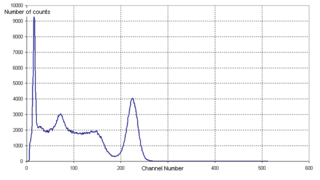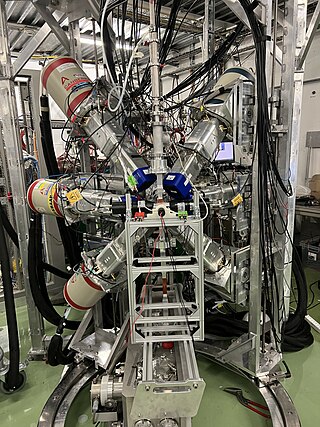Fourier-transform spectroscopy is a measurement technique whereby spectra are collected based on measurements of the coherence of a radiative source, using time-domain or space-domain measurements of the radiation, electromagnetic or not. It can be applied to a variety of types of spectroscopy including optical spectroscopy, infrared spectroscopy, nuclear magnetic resonance (NMR) and magnetic resonance spectroscopic imaging (MRSI), mass spectrometry and electron spin resonance spectroscopy.

X-ray fluorescence (XRF) is the emission of characteristic "secondary" X-rays from a material that has been excited by being bombarded with high-energy X-rays or gamma rays. The phenomenon is widely used for elemental analysis and chemical analysis, particularly in the investigation of metals, glass, ceramics and building materials, and for research in geochemistry, forensic science, archaeology and art objects such as paintings.

A scintillation counter is an instrument for detecting and measuring ionizing radiation by using the excitation effect of incident radiation on a scintillating material, and detecting the resultant light pulses.

A scintillator is a material that exhibits scintillation, the property of luminescence, when excited by ionizing radiation. Luminescent materials, when struck by an incoming particle, absorb its energy and scintillate. Sometimes, the excited state is metastable, so the relaxation back down from the excited state to lower states is delayed. The process then corresponds to one of two phenomena: delayed fluorescence or phosphorescence. The correspondence depends on the type of transition and hence the wavelength of the emitted optical photon.
A semiconductor detector in ionizing radiation detection physics is a device that uses a semiconductor to measure the effect of incident charged particles or photons.

A gamma-ray spectrometer (GRS) is an instrument for measuring the distribution of the intensity of gamma radiation versus the energy of each photon. The study and analysis of gamma-ray spectra for scientific and technical use is called gamma spectroscopy, and gamma-ray spectrometers are the instruments which observe and collect such data. Because the energy of each photon of EM radiation is proportional to its frequency, gamma rays have sufficient energy that they are typically observed by counting individual photons.
Gamma-ray spectroscopy is the qualitative study of the energy spectra of gamma-ray sources, such as in the nuclear industry, geochemical investigation, and astrophysics. Gamma-ray spectrometry, on the other hand, is the method used to acquire a quantitative spectrum measurement.

The ISOLDE Radioactive Ion Beam Facility, is an on-line isotope separator facility located at the centre of the CERN accelerator complex on the Franco-Swiss border. Created in 1964, the ISOLDE facility started delivering radioactive ion beams (RIBs) to users in 1967. Originally located at the Synchro-Cyclotron (SC) accelerator, the facility has been upgraded several times most notably in 1992 when the whole facility was moved to be connected to CERN's ProtonSynchroton Booster (PSB). ISOLDE is currently the longest-running facility in operation at CERN, with continuous developments of the facility and its experiments keeping ISOLDE at the forefront of science with RIBs. ISOLDE benefits a wide range of physics communities with applications covering nuclear, atomic, molecular and solid-state physics, but also biophysics and astrophysics, as well as high-precision experiments looking for physics beyond the Standard Model. The facility is operated by the ISOLDE Collaboration, comprising CERN and sixteen (mostly) European countries. As of 2019, close to 1000 experimentalists around the world are coming to ISOLDE to perform typically 50 different experiments per year.

Mössbauer spectroscopy is a spectroscopic technique based on the Mössbauer effect. This effect, discovered by Rudolf Mössbauer in 1958, consists of the nearly recoil-free emission and absorption of nuclear gamma rays in solids. The consequent nuclear spectroscopy method is exquisitely sensitive to small changes in the chemical environment of certain nuclei.
In health physics, whole-body counting refers to the measurement of radioactivity within the human body. The technique is primarily applicable to radioactive material that emits gamma rays. Alpha particle decays can also be detected indirectly by their coincident gamma radiation. In certain circumstances, beta emitters can be measured, but with degraded sensitivity. The instrument used is normally referred to as a whole body counter.

A gamma ray, also known as gamma radiation (symbol γ or ), is a penetrating form of electromagnetic radiation arising from the radioactive decay of atomic nuclei. It consists of the shortest wavelength electromagnetic waves, typically shorter than those of X-rays. With frequencies above 30 exahertz (3×1019 Hz), it imparts the highest photon energy. Paul Villard, a French chemist and physicist, discovered gamma radiation in 1900 while studying radiation emitted by radium. In 1903, Ernest Rutherford named this radiation gamma rays based on their relatively strong penetration of matter; in 1900 he had already named two less penetrating types of decay radiation (discovered by Henri Becquerel) alpha rays and beta rays in ascending order of penetrating power.

The pandemonium effect is a problem that may appear when high-resolution detectors are used in beta decay studies. It can affect the correct determination of the feeding to the different levels of the daughter nucleus. It was first introduced in 1977.

The Neutron Time Of Flight (n_TOF) facility is a neutron spectrometer at CERN, with the aim of studying neutron-nucleus interactions over a range of kinetic energies, using the time of flight method. The research conducted at the facility has applications in nuclear technology and nuclear astrophysics. The facility has been in operation at CERN since 2001, following a proposal from the former Director General, Carlo Rubbia, for a high-intensity neutron source.
Nuclear forensics is the investigation of nuclear materials to find evidence for the source, the trafficking, and the enrichment of the material. The material can be recovered from various sources including dust from the vicinity of a nuclear facility, or from the radioactive debris following a nuclear explosion.
Conversion electron Mössbauer spectroscopy (CEMS) is a Mössbauer spectroscopy technique based on conversion electron.

A radionuclide identification device is a small, lightweight, portable gamma-ray spectrometer used for the detection and identification of radioactive substances. It is available from many companies in various forms to provide hand-held gamma-ray radionuclide identification. Since these instruments are easily carried, they are suitable for first-line responders in key applications of Homeland Security, Environmental Monitoring and Radiological Mapping. These devices have also found their usefulness in medical and industrial applications as well as a number of unique applications such as geological surveys. In the past two decades RIIDs have addressed the growing demand for fast, accurate isotope identification. These light-weight instruments require room temperature detectors so they can be easily carried and perform meaningful measurements in various environments and locations.

A multichannel analyzer (MCA) is an instrument used in laboratory and field applications to analyze an input signal consisting of voltage pulses. MCAs are used extensively in digitizing various spectroscopy measurements, especially those related to nuclear physics, including various types of spectroscopy.

The ISOLDE Decay Station (IDS) is a permanent experiment located in the ISOLDE facility at CERN. The purpose of the experiment is to measure decay properties of radioactive isotopes using spectroscopy techniques for a variety of applications, including nuclear engineering and astrophysics. The experimental setup has been operational since 2014.

The LUCRECIA experiment is a permanent experimental setup at the ISOLDE facility at CERN. The purpose of LUCRECIA is to analyse nuclear structure and use this to confirm theoretical models and make stellar predictions. The experiment is based on a Total Absorption gamma Spectrometer (TAS) designed to measure beta ray feeding.

The Weak Interaction Studies with 32Ar Decay (WISArD) experiment is a permanent experimental setup located in the ISOLDE facility, at CERN. The purpose of the experiment is to investigate the weak interaction by looking for beta-delayed protons emitted from a nucleus. In the absence of online isotope production during Long Shutdown 2, the experimental setup has also been used to measure the shape of the beta energy spectrum. A goal of the experiment is to search for physics beyond the Standard Model (SM) by expanding the existing limits on currents in the weak interaction.















